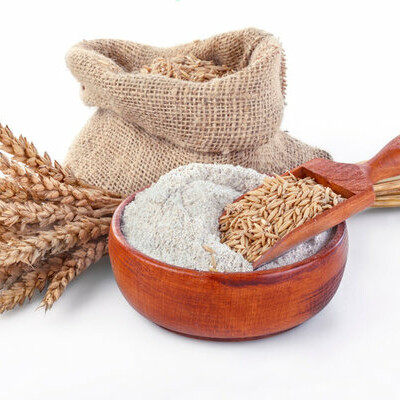Whole Grain Wheat Flour
What is Whole Grain Wheat Flour?
Whole grain wheat flour is made by grinding the entire wheat kernel, mainly from HRW wheat.
Whole grain wheat flour typically has a shorter shelf life than its white flour counterpart. This is mainly due to the presence of the germ which contains lipids prone to oxidative rancidity and enzymes that can trigger deterioration reactions.
As a consequence, whole grain wheat flour has all anatomical components which are key to obtain full load of nutrients, and optimum product flavor, texture and color:
- Starchy endosperm → Rich in starch and gluten proteins
- Bran (pericarp) → Rich in dietary fiber
- Aleurone layer→ Rich in micronutrients (mainly minerals)
- Germ → Rich in enzymes and lipids (unsaturated fatty acids)
Origin
Whole grain wheat flour is obtained from the Triticum aestivum kernel. Wheat is one of the oldest crops which dates back to the Stone Age. Its domestication started in the Tigris and Euphrates River Valley.1
The industrial development of whole wheat flours is fairly recent and was driven by the rediscovered health benefits of the bran, germ proteins and dietary fiber. Today, China, India and the US are among the main producers of wheat in the world.
Function
Whole grain wheat flour has several functions in baked goods, including:
- Structure building → Provides gluten and starch for crumb-setting upon baking
- Water absorption → Whole grain wheat flour components, such as starch, gluten-forming, proteins and arabinoxylans, bind water to form a cohesive polymeric matrix in batter and dough
- Flavor → Imparts a richer nutty flavor to artisan and sourdough bread due to the presence of the bran and germ
- Color (HRW wheat) → Provides a characteristic brownish or reddish color thanks to the pigments present in the bran
- Nutrition quality → High dietary fiber, proteins, minerals and vitamins are responsible for the higher nutritional value of WGWF compared to regular wheat flour
Commercial production
Whole grain wheat flour is usually produced using stone mills and hammer mills. Given its nature, there is no need to temper the wheat before milling. Only wheat cleaning and size reduction are needed in the production process, so plansifting and purifying operations are not required.
Nutrition and health
The presence of the bran makes whole grain wheat flour naturally rich in insoluble dietary fibers and antioxidants. It also contains full load of wheat germ, a rich source of protein, vitamins E and B complex, minerals, and bioactive phytochemicals.2
Consumption of whole grains may help reduce the risk of several chronic diseases and certain cancers owing to the antioxidant properties of their constituents.2,1
Macro- and micro-nutrients of whole grain wheat flour1
| Constituent | Value |
|---|---|
| Moisture | 10.74% |
| Calories | 340 KCal / 100 g |
| Protein | 13.21% |
| Lipids | 2.50% |
| Saturated fatty acids | 0.43% (total lipids) |
| Monosaturated fatty acids | 0.283% (total lipids) |
| Polyunsaturated fatty acids | 1.167% (total lipids) |
| Total dietary fiber | 10.7% |
| Total carbohydrates | 71.97% |
| Sugars | 0.41% |
| Potassium (K) | 363 mg / 100 g |
| Calcium (Ca) | 34 mg / 100 g |
| Phosphorus (P) | 357 mg / 100 g |
| Magnesium (Mg) | 137 mg / 100 g |
| Thiamin | 0.502 mg |
| Riboflavin | 0.165 mg |
| Niacin | 4.957 mg |
| Vitamin B6 | 0.407 mg |
| Folic acid | 44 μg |
Application
Bread doughs made with whole-grain wheat flour have typically higher water absorption than those made from white flour. This is due to the higher amount of water required to hydrate bran’s non-starch polysaccharides.
During breadmaking, the fiber and bran particles in the flour tend to exert a “cutting or tearing” effect on the continuous gluten network created during mixing, hence decreasing dough’s gas-retention capacity and leading to a loaf of bread which has a lower volume and denser texture.
To offset the detrimental effect of bran particles and also create a softer crumb, hydrolytic enzymes, such as maltogenic amylase and xylanase, are added. Vital wheat gluten, glucose oxidase (GOX) and ascorbic acid, can also be used to increase gas retention and protect the integrity of the expanding dough during oven spring.
References
- Finnie, S, and Atwell, W.A. Wheat Flour. 2nd edition, AACC International, Inc, 2016.
- A.A, Inamdar, and S.D. Sakhare. “Wheat.” Whole Grains Processing, Product Development, and Nutritional Aspects. CRC Press Taylor & Francis Group, 2019, pp. 235–255.


